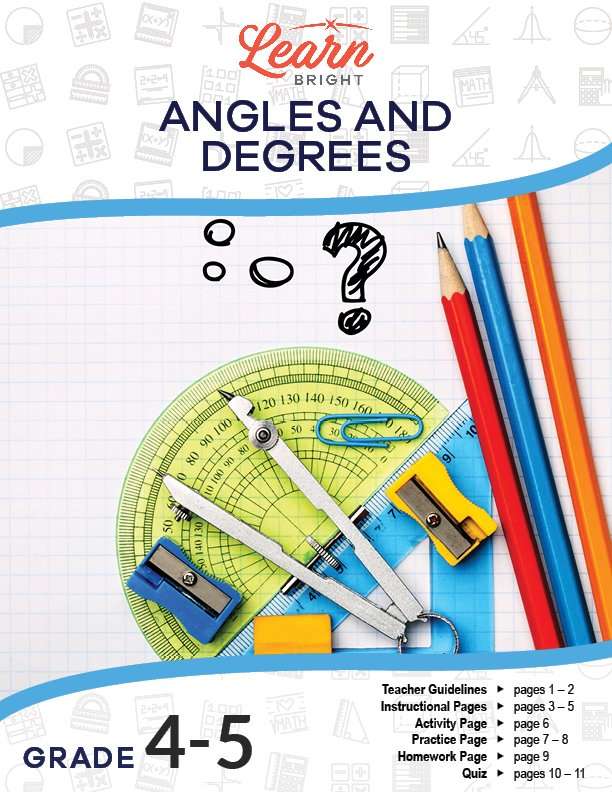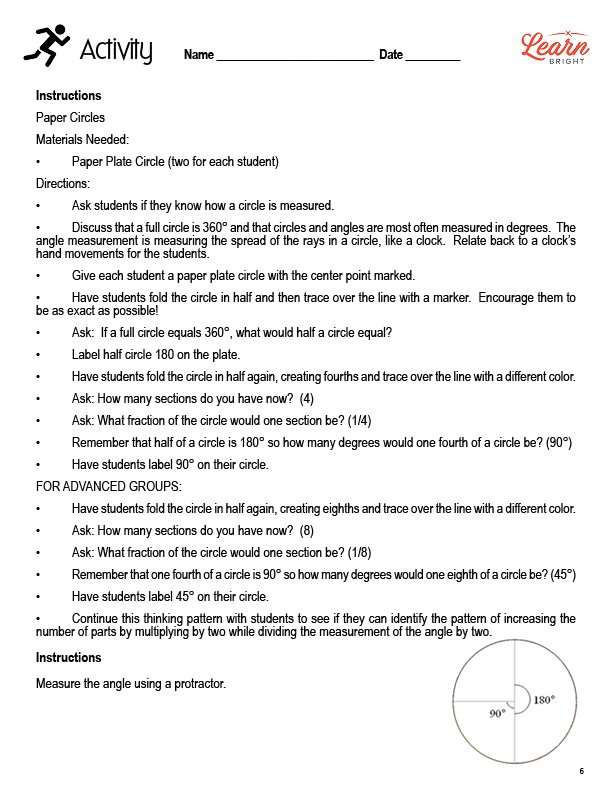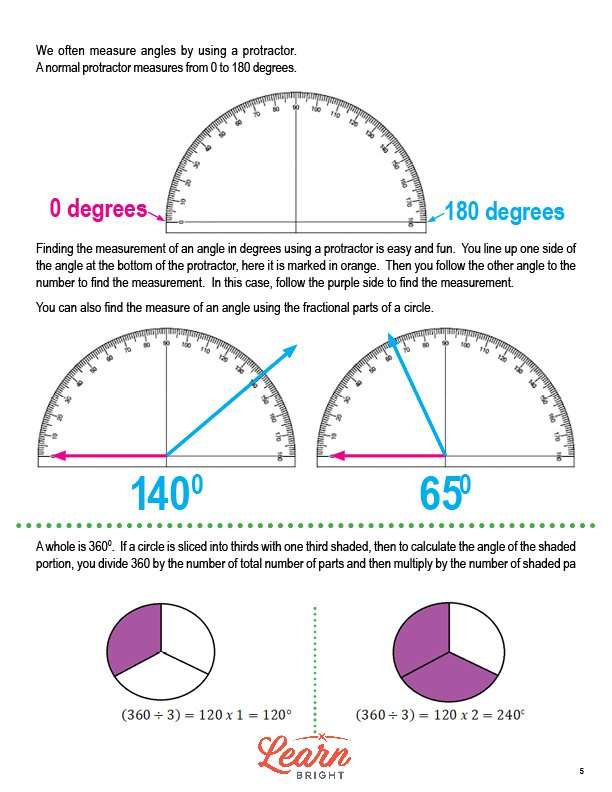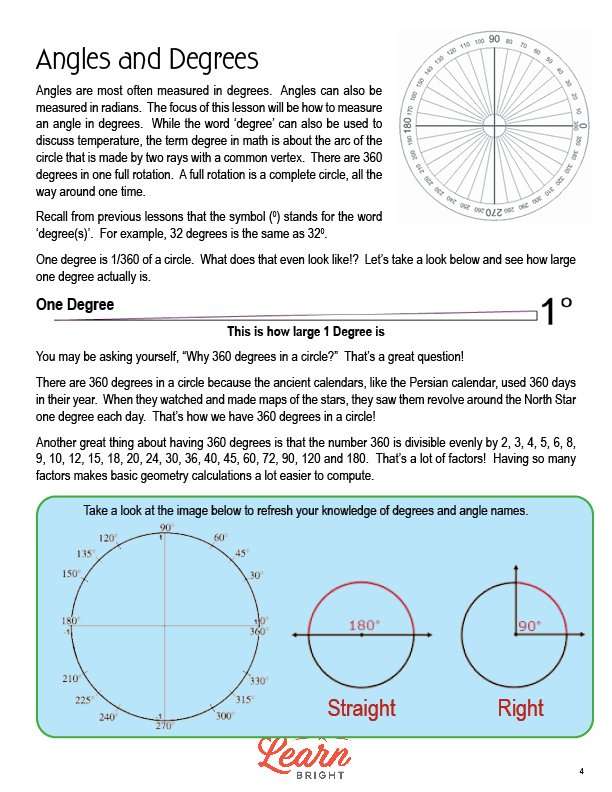Description
What our Angles and Degrees lesson plan includes
Lesson Objectives and Overview: Angles and Degrees teaches students how to measure an angle in degrees. The lesson illustrates the size of one degree and explains why there are 360 degrees in a circle. It also demonstrates with illustrations how to use a protractor to measure an angle. At the end of the lesson, students will understand that an angle that turns through n one-degree angles is said to have an angle measure of n degrees. This lesson is for students in 4th grade and 5th grade.
Classroom Procedure
Every lesson plan provides you with a classroom procedure page that outlines a step-by-step guide to follow. You do not have to follow the guide exactly. The guide helps you organize the lesson and details when to hand out worksheets. It also lists information in the blue box that you might find useful. You will find the lesson objectives, state standards, and number of class sessions the lesson should take to complete in this area. In addition, it describes the supplies you will need as well as what and how you need to prepare beforehand. The supplies you will need for this lesson are paper plates, markers, and protractors. To prepare for this lesson ahead of time, you can copy the handouts, gather the materials, and place a center point in each paper plate for the activity.
Options for Lesson
Included with this lesson is an “Options for Lesson” section that lists a number of suggestions for activities to add to the lesson or substitutions for the ones already in the lesson. One optional addition to this lesson is to have students draw angles for each other to measure using a protractor. You can also have students draw a picture using all different angles. Finally, you could also have students research why there are 360 degrees in a circle and what the history is behind determining that measurement.
Teacher Notes
The teacher notes page includes lines that you can use to add your own notes as you’re preparing for this lesson.
ANGLES AND DEGREES LESSON PLAN CONTENT PAGES
Angles and Degrees
The Angles and Degrees lesson plan includes two content pages. The lesson begins with some basic information about angles and degrees. It states that angles are most often measured in degrees, but can also be measured in radians. However, the focus of this lesson in particular is how to measure angles in degrees. Mathematical degrees are different from the degrees that we use to measure temperature. Mathematical degrees measure the arc of the circle that is made by two rays with a common vertex. One full rotation, or a complete circle, has a total 360 degrees. The degree symbol (°) stands for the word degree. One degree is 1/360th of a full circle. The lesson then includes a drawing that shows how large one degree is.
Students will then learn why there are 360 degrees in a circle. Ancient calendars, like the Persian calendar, had 360 days in a year. They mapped the stars and noticed that they revolved around the North Star by one degree every day. This is why circles have 360 degrees! Using 360 is convenient because it is easily divisible by many numbers, like 2, 3, 4, and 5 (and many more!). This means there are lots of factors, which in turn means that basic geometry calculations are easy to do. The lesson then includes a few images to help students remember some different degree and angle names.
Next, students will learn that we measure angles using a tool called a protractor, which can measure between 0 and 180 degrees. The lesson includes several diagrams of protractors to illustrate different features of them and how to use them to measure angles. In order to measure an angle using a protractor, you simply line up one side of the angle at the bottom of the protractor, then follow the other angle to the number to find the measurement. Another way to find the measure of an angle is to use the fractional parts of a circle.
Finally, the lesson notes again that a whole circle is 360°. To find the angle measurements of equal parts of a circle, you divide 360 by the number of equal segments. For example, to find the angle of one third of a circle, you divide 360 by the number of total number of parts (three) and then multiply by the number of parts you want to find the angle for (one). The degree measurement of one third of a circle is 120°. The equation you use to figure that out, as stated in the lesson, is (360 ÷ 3) = 120 x 1 = 120°. The lesson also includes a second example.
ANGLES AND DEGREES LESSON PLAN WORKSHEETS
The Angles and Degrees lesson plan includes three worksheets: an activity worksheet, a practice worksheet, and a quiz. You can refer to the guide on the classroom procedure page to determine when to hand out each worksheet.
PAPER PLATE ACTIVITY WORKSHEET
For the activity worksheet, students will follow your verbal instructions. First, you should ask students if they know how to measure a circle. Next, you should inform them that a full circle measures 360°, that circles and angles are measured in degrees, and angle measurements measure the spread of the rays in a circle. It’s a good idea to relate this idea to a clock. Next, you will give each student a paper plate with the center point marked and have them fold it in half and trace that line with a marker as precisely as possible. Then you will ask the students what half a circle equals if a full circle equals 360°. Students will label the half circle as 180° and then fold it in half again. They will label these four sections 90° each after you ask them what half of 180° would be.
For advanced groups, you can then continue the activity with eight sections, having students label those 45°. You can continue this pattern and ask students to think about identifying the pattern of increasing the number of parts by multiplying by two while dividing the measurement of the angle by two.
PROTRACTOR PRACTICE WORKSHEET
The practice worksheet includes two sections. For the first section, students will measure given angles using a protractor. Next, they will have a friend or family member draw eight different angles and then measure those angles using a protractor.
ANGLES AND DEGREES QUIZ
This lesson also includes a quiz. For the quiz, students will first match the angle with the estimated degree. Next, they will look at diagrams of angles and estimate the degree of each angle by eye. This quiz will test students’ understanding of the lesson material.
Worksheet Answer Keys
This lesson plan includes answer keys for the practice worksheet and the quiz. No answer key is provided for the activity worksheet. If you choose to administer the lesson pages to your students via PDF, you will need to save a new file that omits these pages. Otherwise, you can simply print out the applicable pages and keep these as reference for yourself when grading assignments.









